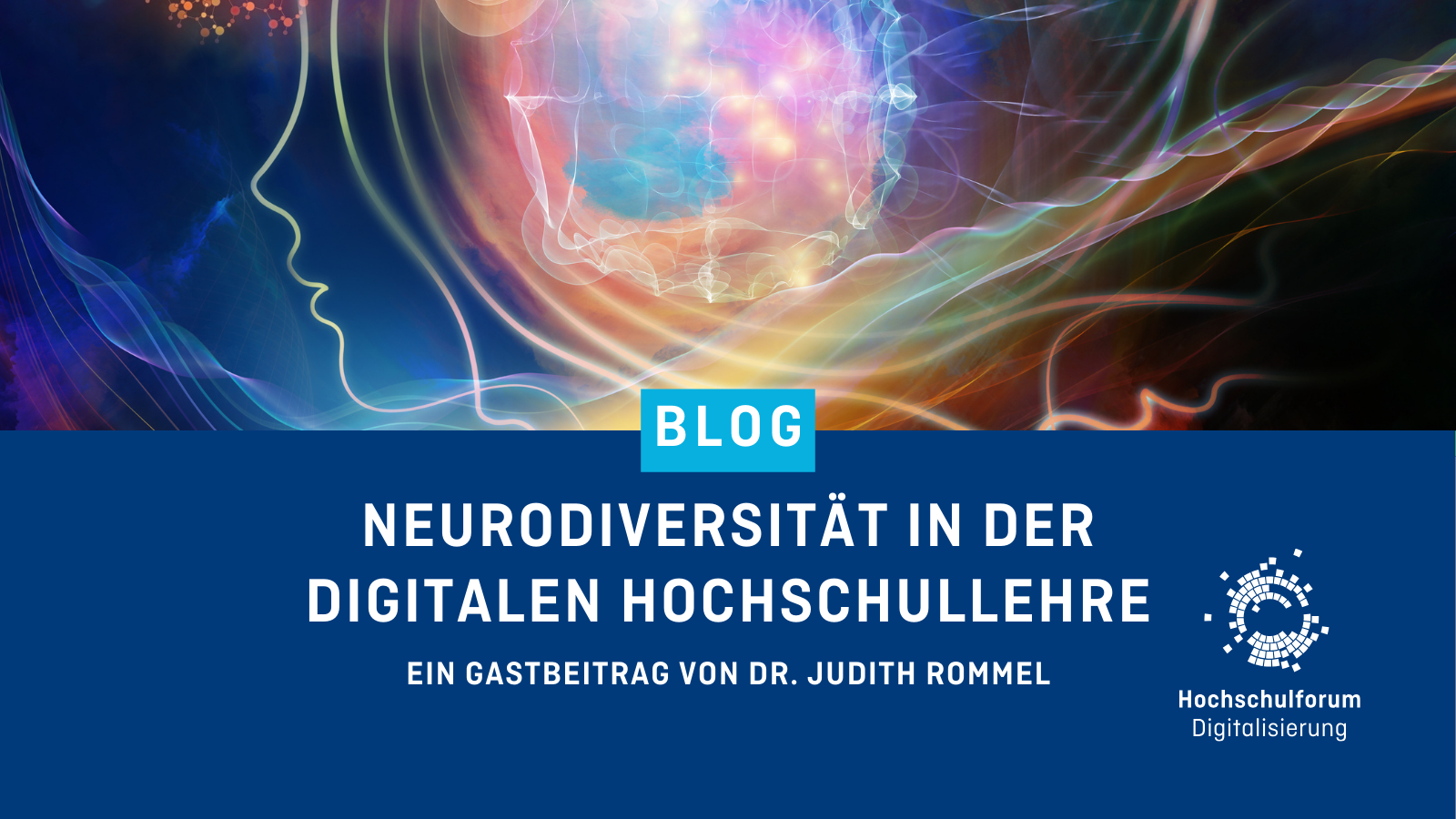Neurodiversity in digital university teaching
Neurodiversity in digital university teaching
31.01.24
University teaching that promotes or perhaps even celebrates diverse styles of thinking and learning not only creates an inclusive environment, but also offers added value for all teachers and students. In this article, we explore why neurodiversity is crucial in the digital world of higher education and how to practically address the different needs of neurodivergent people in higher education. Individual self-efficacy and a sense of community can be promoted through freedom of choice in dealing with technology and mutual empathy.
Imagine a university environment that not only imparts knowledge, but also values and nurtures the unique mindsets and potential of everyone in it. Digital university teaching offers plenty of scope to do justice to an important dimension of diversity – neurodiversity. The term “neurodiversity” refers to the fact that people have different brains and nervous systems. People therefore process information from their environment in different ways.
(1) This influences, among other things, attention, learning, imagination and communication with each other. Neuroatypical (also known as neurodivergent) people perceive the world and sensory stimuli in a different way to neurotypical people. Neuroatypias include ADHD (approx. 5% of the population), autism (0.6% – 1% of the population), dyscalculia (3-7% of the population), dyslexia (4-8% of the population), synaesthesia (4-5% of the population) and giftedness (approx. 2% of the population).
(2) This also includes an increased sensitivity to environmental stimuli such as smells, noises and light. Overall, around one in five people in Germany live with some form of neurodivergence. A group of people is neurodiverse if one or more members of the group have a different way of functioning in their neurocognitive processing. This article uses specific examples to raise awareness of the importance of neurodiversity in digital university teaching and provide practical guidance.
I. Why knowledge of neurodiversity is important in digital university teaching
Learning involves absorbing information via sensory channels. People differ in terms of which sensory channels they prefer when learning. Many people are visually oriented and like to learn by observing and seeing. Others learn better aurally by listening and speaking. And kinaesthetically oriented people learn by doing something, feeling something with their hands, perceiving smells or tasting something. Learners can often use a mixture of these sensory channels, but often have a preferred system for perceiving, storing and reproducing data.
In addition to hypersensitivity or hyposensitivity of sensory perception (e.g. sensitivity to sound versus only 50% hearing), neuroatypical learning and communication present further challenges that teachers can consciously address. These include, for example, distractibility or difficulties in maintaining concentration for longer, word-finding and language problems, difficulties in dealing with number concepts or reading, or limitations in movement coordination and spatial awareness.
Sometimes neurodivergence also manifests itself in the fact that people find it difficult to direct their behavior towards a goal or that they have difficulty interpreting the body language and facial expressions of other people. All of this can even be accompanied by giftedness and high intelligence with a quick grasp of things. Therefore, “digital teaching formats must appeal to diverse learning styles, offer accessible content and allow for individual adaptations to meet the needs of all students.”– Elli, autistic with Asperger’s
The experiences mentioned below mainly relate to purely online teaching. Most aspects can be transferred to face-to-face events with digital tools. All verbatim quotes are from students and professors from the Bachelor of Science in Computer Science program.
II. Neurodiversity in digital university teaching: advantages and challenges from the perspective of teachers and students
A major advantage of digital teaching is that neurodiversity, i.e. heterogeneous groups with and without neurodivergences, can be taken into account individually. For example, “alternative presentation methods, interactive elements and flexible learning structures with regard to text, color, sound and control elements. It should be possible to adjust these alternatives according to individual needs so as not to negatively influence the learning process of others.” – Max Wilhelm
Digital accessibility means that many different, often conflicting needs need to be taken into account. These go beyond the requirements of the W3C or WCAG standards for accessibility on the Internet (3,4). Accessible (or rather low-barrier) learning platforms are extremely beneficial in order to easily and efficiently implement an inclusive and pleasant learning environment for all. What is particularly remarkable is that there are so many benefits for everyone:
In addition to this technical flexibility, digital teaching enables independence in terms of space and time, thus creating access to individually adaptable digital learning resources.
“Instead of a strict online attendance requirement, for example, lectures could also be recorded so that each student can watch them again at their own pace and, if necessary, with breaks.” – Tatjana
Online teaching makes it easier for people with allergies and sensitive reactions to environmental stimuli such as sounds, smells, touch, colors or light to participate in their studies. At home in self-designed rooms, they encounter far fewer invisible barriers than in public buildings.
Digital teaching “gives me the opportunity to work in my familiar surroundings without any major distractions. It also means I don’t have to travel back and forth, which saves stress and time. For me, it’s a challenge every time I travel to the university and sit in the lecture. I’m really glad that some lecturers have kept the online or hybrid lectures.” – Elli, Asperger autistic
Many students see advantages in the fact that they can concentrate better during virtual appointments and that lectures or meetings are better integrated into their everyday lives. Students confirm this positive effect, regardless of whether they are neurodivergent or not. Less commuting time, direct accessibility and location-independent working play an important role here, as this also helps the chronically ill or people with family responsibilities in particular to progress and learn at their own individual pace. The advantages also outweigh the disadvantages from the point of view of teachers with neurodivergences:
However, there are also some challenges: “I sometimes find it difficult to notice the loss of connection, as you only have one exam a semester and therefore hardly get any interim feedback. I think the overall disadvantage of online lectures is that you have to have a lot of self-discipline.” – Paul
Other students describe challenges in communication: “The audiovisual transmission devours some of the gestures and facial expressions, which significantly reduces the personal connection to the lecturer, for example.” – Tatjana
In addition to the difficulties in deciphering facial expressions and gestures, the lack of emotional connection within the group and with lecturers is also cited as an obstacle to mutual understanding. It is important that misunderstandings are cleared up in a personal conversation and that short follow-up questions are possible. Teachers confirm these challenges: “The disadvantage of the online format is the lack of contact with the students. Tools for online meetings do allow interaction between the lecturer and the student, but in my experience there is much less exchange than in face-to-face courses.” – Mario, professor on the computer science course
And from the students’ point of view, it is:
III Solutions for joint communication and social integration
Overall, students and teachers want better contact and exchange, regular feedback, good support with self-organization and a pleasant environment that is tailored to their own needs when teaching purely online. How can good bonds and strengthening interpersonal interactions be created in digital teaching?
Students can have better contact and exchange with teachers if they have time for it. A tutor system like the Oxbridge Colleges opens up spaces for deeper discussion and regular contact. Digital tools also simplify accessibility and enable more frequent, location-independent meetings. Individual approaches can then be developed in small groups to support students’ self-organization (e.g. breaking down goals into small steps, recommending project management tools for individual tasks). Suitable strategies for dealing with neurodivergences can also be discussed more easily in personal contact.
People whose sensory channels are oversensitive or undersensitive, e.g. noise sensitivity or hearing loss, have low-threshold opportunities online to create the right environment for them and experience virtual community in discussion forums. People who are more sensitive to stimuli in particular are better able to maintain focus in their own environment. Online peer mentoring groups or hybrid formats in which students choose whether to follow lectures from home or in the classroom are therefore advantageous. People with other forms of neurodivergence, on the other hand, prefer on-site events because they are much less distracted. When dealing with neurodivergences, it is important that, in the best case scenario, each group of people defines their individual needs in terms of joint communication so that people are comfortable with this. Unpleasant challenges otherwise arise, especially in group work. Here students suggest: “Instead of forming groups at random, they could also organize themselves. organize themselvesto better play to their strengths and compensate for weaknesses.”- Tatjana,- Because teams that cover important roles well, from moderation and task planning to cheerleading for timely delivery, are more successful.
Conscious communication is a crucial key to ensuring that neurodiverse groups get on well together. Teachers should therefore find out the communication styles of the participants as soon as possible and sensitize the learning group to them. Paying attention to your own speaking speed and being open to repeating sentences when necessary also helps neurodivergent people. If someone has difficulties with social communication, it is often enough to explicitly state the next steps in the interaction, e.g. “Come in and we’ll say hello”. Some people carry communication cards with them, which they use to communicate when a verbal exchange is no longer possible due to sensory overload. Knowledge transfer as a central task of universities and colleges “in addition to the meaningful preparation of the knowledge (…) by the lecturer, the students’ capacity to absorb it must also be taken into account, which in the case of neurodivergent persons depends massively on the direct environment during the transfer of knowledge (lecture).” – Mario, professor in the computer science program It would therefore be desirable for all university and college staff to be aware of neurodivergences and for strategies for dealing with them to be institutionalized.
Teachers can ensure equal opportunities by establishing clear routines in lessons and, for example, providing timers for phases in which concentration without distraction is important. It also helps to regularly reflect with learning groups on their individual needs and measures. On an institutional level, the opportunity to study part-time and learn at your own individual pace takes pressure off. People can then take part in courses in a more relaxed way. “In my opinion, however, it is particularly important that all students know that they are in a safe space. By that I mean that (…) they can talk openly about their individual strengths and weaknesses.” – Tatjana –
If teachers succeed in creating such a learning atmosphere, there is room for community instead of discrimination and stigmatization. In direct contact with each other, needs can be balanced and solutions to conflicts can be found. For good contact, it is important that all “negative influencing factors can be removed from the direct learning environment. In the case of electrosensitive students, for example, this means that the lecture room can be made radio-free.” – Mario, professor on the computer science course
This presupposes that people in digital spaces have freedom of choice in their use of technology, both offline and online, and that digital technology can be adapted to different groups of people.
IV. Conclusion
Neurodiversity is evident in digital university teaching through the many different needs of teachers and students. The processing of sensory impressions plays a major role in communicating with each other. Learning requires communication and relationships, which is why awareness and knowledge of how to deal with different neurodivergences are very important in digital teaching.
Many strategies to create inclusion and equal opportunities for neurodivergent people also bring some added value for neurotypical students and university staff. These include a higher degree of individualization, the openness to communicate about one’s own needs and personal strengths in a safe environment, as well as spatial and temporal flexibility.
Learning at your own pace and in a self-designed, sensory-friendly (digital) space brings many opportunities and some challenges. The solutions described in the article show low-threshold measures for coping. In practice, many adaptation steps are cost-effective and convenient for all students. Neurological diversity must be reflected in technical and digital university environments, and this goes beyond the provision of right- and left-handed mice. Freedom of choice in the use of technology helps to ensure that measures effectively break down barriers and are good for the health of everyone involved. It is therefore of great importance that teachers and strategists at universities and colleges are sensitized to the topic of neurodivergences. They have a decisive influence on ensuring that software and digital learning are designed to be more accessible and that cooperation at colleges and universities is characterized by vitality and appreciation.
Footnotes / References:
(1) (https://neuroqueer.com/neurodiversity-terms-and-definitions/)
(2 ) Frequency as a percentage of the population in Germany:
Autism: 0.6% – 1% https://www.umweltbundesamt.de/themen/gesundheit/umweltmedizin/autismusautismus-spektrum-stoerungen#welche-risikofaktoren-sind-bekannt
ADHD: approx. 5% of the population
Dyscalculia: 3-7 %
Dyslexia: 4-8%
Plume, E., & Warnke, A. (2007). Definition, symptoms, prevalence and diagnosis of reading and spelling disorder. Monatsschrift Kinderheilkunde. doi: 10.1007/s00112-007-1480-2
(3) W3C and WCAG standards:https://www.w3.org/TR/wcag-3.0/
This blog post was written in cooperation with the HFD think tank “Chancengerechtigkeit”, headed by Tina Basner. Feel free to share your ideas with us and the HFD community via the comment function or contact us by e-mail at judith.rommel@dhbw-stuttgart.de or tina.basner@che.de.



 Steve Joordens
Steve Joordens 
 Michael Siegel
Michael Siegel 
 Anna Scarcella
Anna Scarcella 